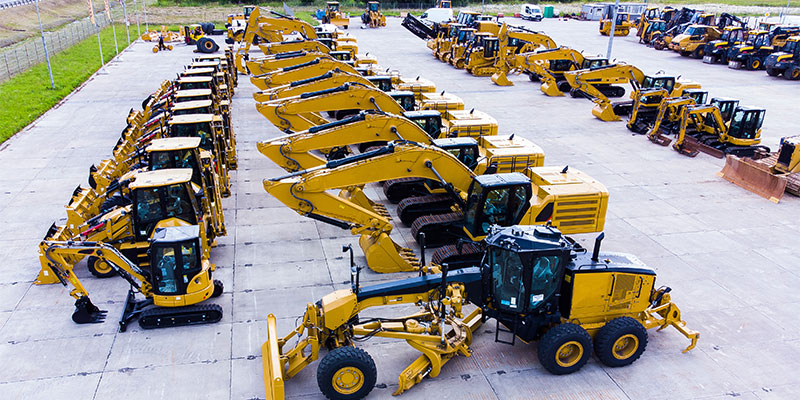Types of construction vehicles are used to lift, move, or level loads. It is quite ideal for handling jobs that are impossible for manpower to handle. For example, cranes lift loads that people cannot carry to high places, while the crane counterweight is used to provide balance and stability. These tools save both time and manpower. Also, they work faster and more efficiently. Types of construction vehicles with different equipment are used for different needs so that the work to be done can be handled completely. For the control and use of each vehicle, an operator who knows how to use that vehicle is also required.
Types of Construction Vehicles
The construction sector uses different types of construction vehicles. Each vehicle is used for another job and meets another need. They are very life-saving tools for heavy tasks that cannot be done by man-handling such as excavation, unloading, or lifting. These vehicles are used in almost every job in the construction sector. Different jobs that need to be done require different types of construction vehicles. Knowing which one is necessary for the job is important to working efficiently.
1. Dump Trucks
One of the most frequently used construction vehicles are dump trucks, which are mainly used to unload rubble or transport additional materials to the construction site. Its case is a wide-angle cast case, and it is produced in accordance with the transportation of soil, rubble, and heavy construction materials. In addition to these, the dump trucks are equipped with a hydraulic system and are height adjustable. In this way, the unloading process takes place much more safely in these types of construction vehicles.
2. Backhoes
It is a versatile machine and is generally preferred for digging or leveling. It can easily go into rough terrain where other types of construction vehicles cannot easily enter. The digging part takes place at the back, and the bucket section, which can carry the materials, takes place at the front. The excavation part is doing the work, such as digging soil and pits or trenching. It has a very practical use, as it can easily enter narrow and rough terrain among the types of construction vehicles.
3. Grader
This vehicle, which has a long and adjustable blade, is used to create a flat surface. It is generally preferred in road construction because it is used not only to level the road but also to prepare the road site for asphalt.
4. Bulldozers
Bulldozers are the most commonly used vehicle in the construction area. It is very popular among all types of construction vehicles. It has a large blade at the front and is used to scrape, push, or carry materials. Bulldozers are the most powerful type of vehicle because they can go anywhere on any terrain. It is used to remove rubble, bushes, or trees, dig trenches, or do agricultural work.
5. Front Loaders
Front loaders are used to carry loads by using the section in front of them. Also called a bucket loader. It has large wheels for easier use on rough terrain. The bucket on the front is removable and replaceable. These vehicles, which are very suitable for transporting materials, are similar to bulldozers, but the operator’s cabin is located much higher.
6. Loaders
It is used to load and transport materials at the construction site. It carries materials such as rock, recycled materials, stone, or asphalt. It can be produced on wheels or pallets. There are many types of loaders. And each loader is used for different jobs.
7. Cranes
Cranes are quite functional and are found on every construction site. It is ideal for carrying and lifting heavy loads. There are also different types within themselves, such as wheeled and plated, static, and mobile. Each crane has a different function. They are used in different areas.
8. Compactors
It is preferred for compacting materials such as soil, sand, or gravel. Compactors are produced with cylindrical or plate-shaped structures. These structures compress or flatten materials by exerting pressure on them. Some models are also equipped with vibratory mechanisms for more effective compaction. It is generally used in road construction projects.
9. Excavators
This type of construction vehicle is part of the excavation equipment and is quite powerful. It has a rotating cabinet, movable pallets, and an arm. It can do many tasks effortlessly with these parts. Excavators can be used not only to transport heavy materials but also to level uneven terrain, dig deep trenches, or demolish walls.
10. Conveyors
These machines are preferred not only in the construction sector but also in many different sectors such as agriculture, automotive, mining, or aviation. Conveyors are used for the transportation of the materials. Wheeled conveyors are very useful on the construction site and transport materials such as large stones and bricks.
11. Articulated Haulers
Articulated haulers are also named dump trucks. They are used for the transportation of large quantities of materials. Unlike other dump trucks, articulated haulers have a pivot joint and thus have more mobility. With the help of this part, the rear wheels follow the direction of the front wheels, and the turns are tighter. They can maneuver safely in all kinds of obstructed terrain.
12. Cold Planers
These tools are used for grinding and removing materials such as asphalt or pavement. It is also preferred for the preparation of the asphalt surface, especially in road construction works. The principle of this type of construction vehicle is quite simple; It crushes and grinds old asphalt and pavement and then transports this material for recycling. Operators must be skilled and trained to use this vehicle.
13. Concrete Mixer Trucks
It is a type of construction vehicle that mixes different materials homogeneously to form pavement. This process is carried out with cement, sand, or gravel. It usually consists of a truck-mounted mixer. If less pavement is needed at the construction site, a more portable version is preferred instead of this large truck.



